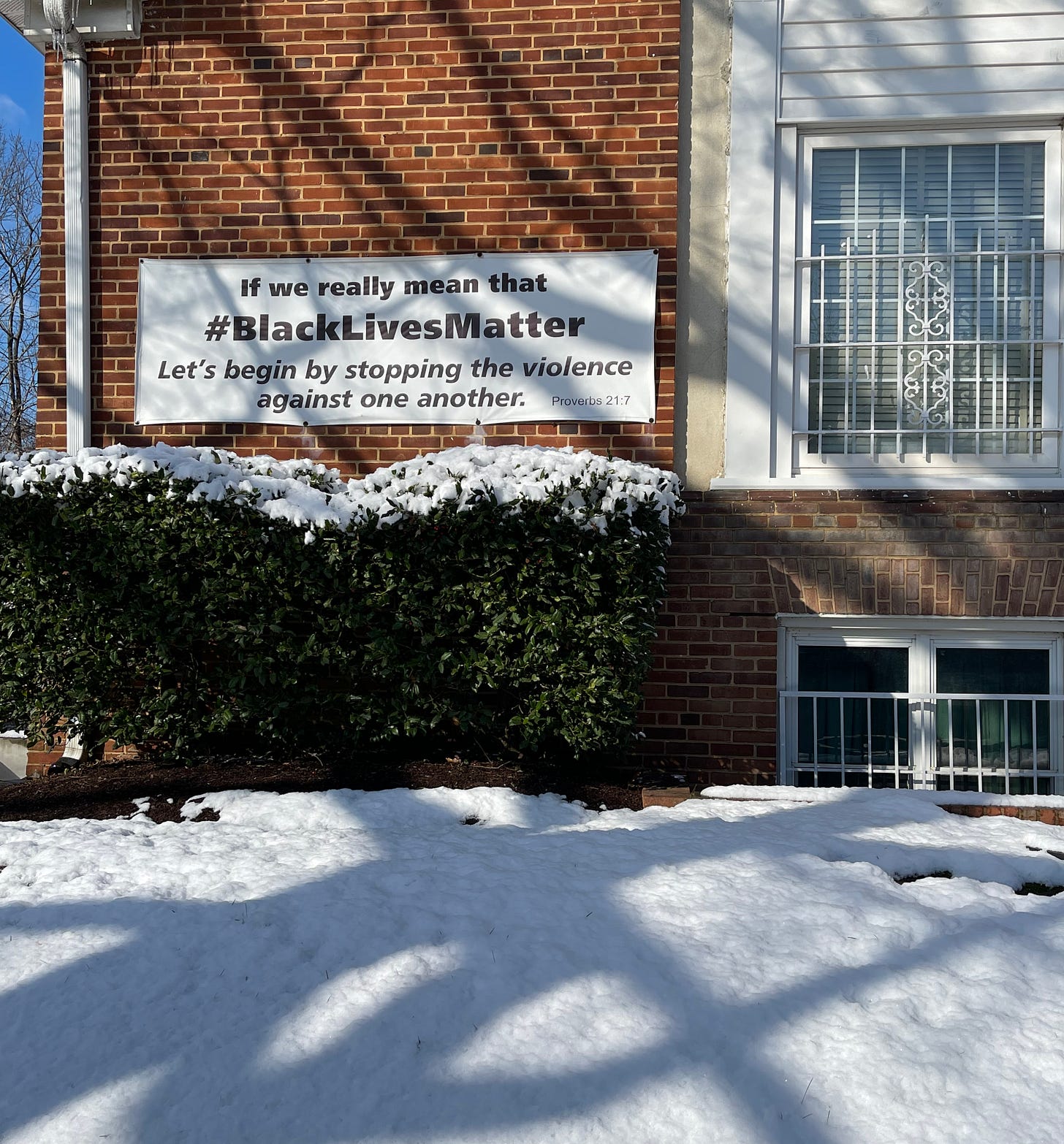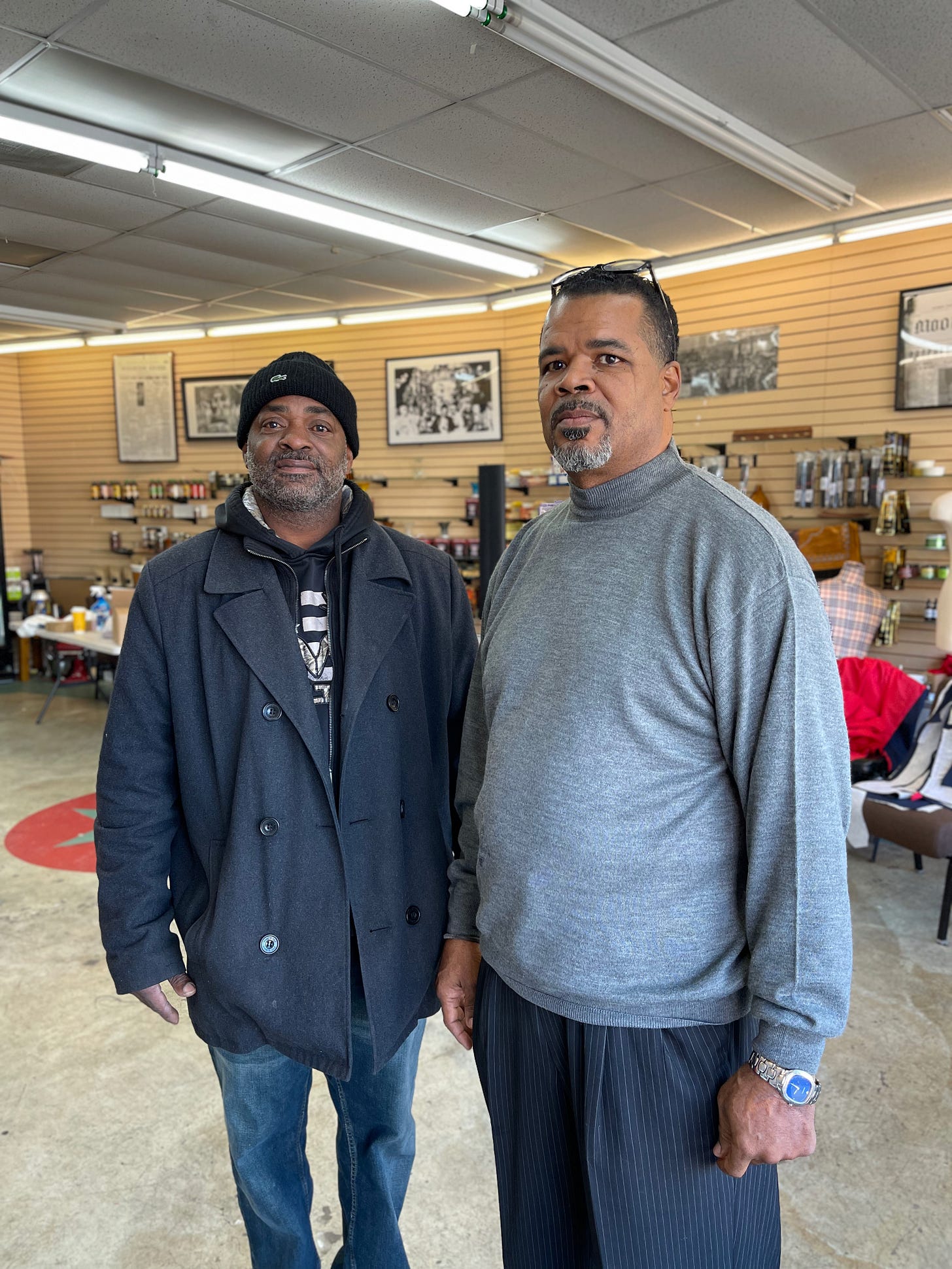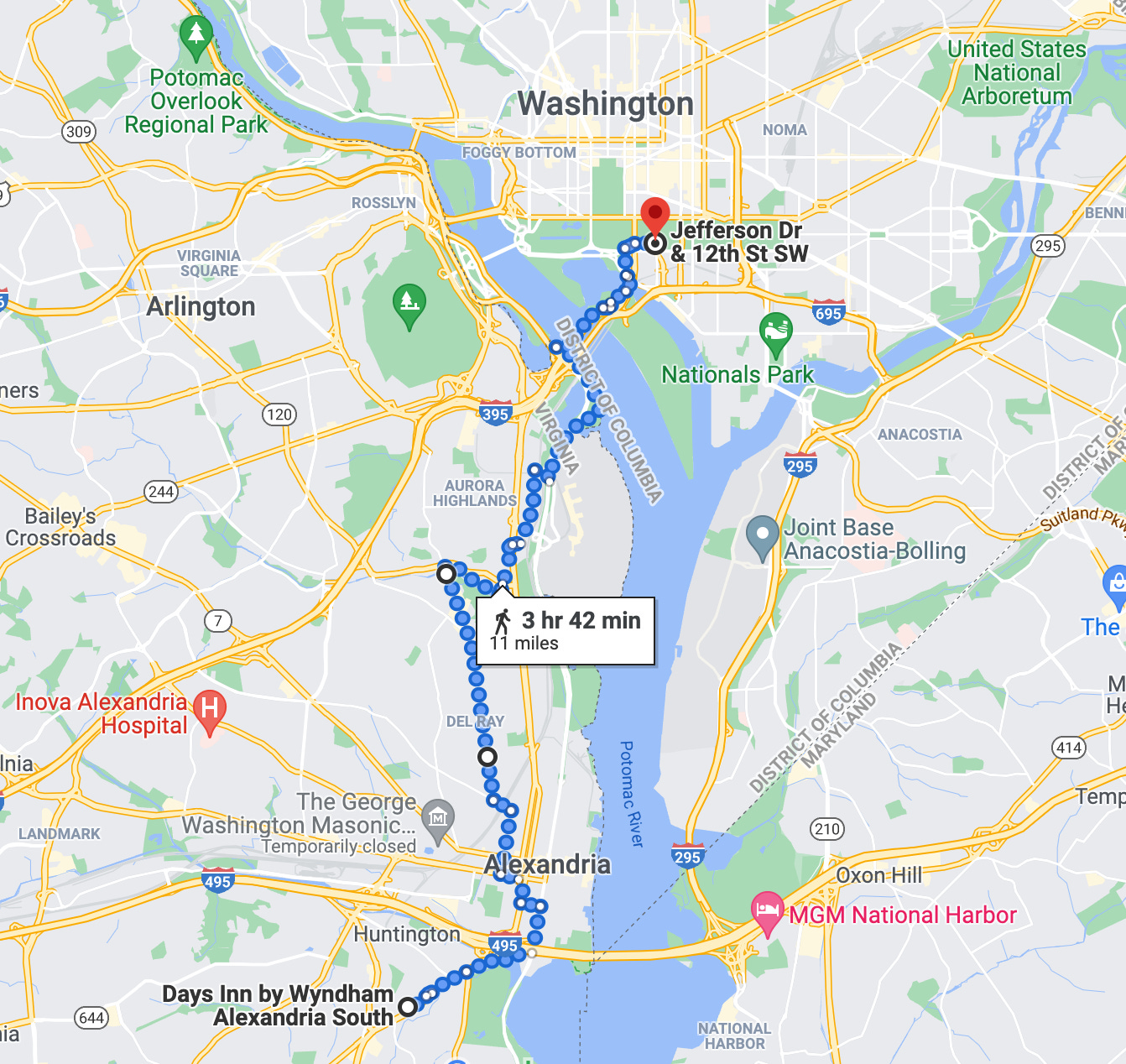Walking America: Washington, DC (Anacostia and Alexandria)
Walking through the Democratic coalition of blacks and highly educated whites
Washington, DC is the go-to stereotype for a city of highly educated elites removed from the country they govern. That DC exists, but it is confined to parts roughly in the north western half. The rest of DC, especially east across the Anacostia river, is a working class town right out of “Flyover America.”
That doesn’t mean the elites of DC are tight with the normie parts of town only miles and a few subway stops away. People, especially elites, have an amazing capacity to stick to their own, usually under the guise of safety.
Crime in DC, like everywhere, is clustered, and in this case mostly in the south and east. When I announced I was going walk twelve miles to the White House, via the largely black neighborhoods that fill the southeastern parts of DC, I was told over and over, “Be careful,” “Don’t get mugged,” and so on.
While some of that concern might be well-intentioned, it is a fundamental misunderstanding of crime. In the neighborhoods of southeastern DC, with crime maybe five or ten times higher than, oh, Georgetown or Alexandria, the overwhelming bulk of residents are still law-abiding and decent citizens. The baddies causing trouble are still a minority, just a slightly less tiny one.
To define these communities by crime is both wrong and letting those baddies win. They are much more than that.
I saw that in my first walk from the historic neighborhood of Anacostia along Minnesota Ave, up to the less idyllic, more project-y, Benning, then across the Ethel Kennedy Bridge, into the now just-beginning-to-gentrify Trinidad neighborhood.
Based on all the negative talk, I had expected to find signs of hard drugs. Needles, tiny baggies, desperate-looking people tweaking or hitting me up for money. That happens all the time in “Flyover America.” There was none of that here, beyond one older women, wrapped tight, without her dentures, looking rough, who asked for food money. I bought her a sandwich and a coffee, which she accepted and ate, without trying to make excuses that she needed the cash only.
I had also expected to find burned-out buildings, abandoned lots, but instead I found well-kept modest homes stamped with usual domestic stuff like flags, kitchy statues, and lots and lots of crosses.
If one believed the talk, I should have also been threatened. Sure, there were the usual men congregating on corners drinking tall boys. I guess one could see them as threatening, but as usual, they just waved at me, or fist bumped me, or jokingly posed for pics, but otherwise left me alone.
The church-going ladies and men, however didn’t leave me alone. Two times they saw a man who needed to be talked into the Lord.
That, far more than crime, is what southeastern DC is filled with, and what defines it: An in your face “be saved or suffer” religiosity. One that deeply informs the lives and realities of the residents, in a way that makes elites uncomfortable, but anyone from “Flyover America” wouldn’t find the least bit odd.
That deep religious faith also impacts how the neighborhood confronts and sees the crime that does indeed exist. You see it in slogans plastered all over, both on lawn signs, church signs, and billboards. Rather than “Defund the police” there are, “Pray for peace” or “Let’s get our kids off our streets and into the pews,” and “If we really mean BlackLivesMatter, let’s begin by stopping the violence against one another.”
That isn’t to say crime isn’t a problem. It is, and more clearly so as you get north near Benning Road, where there is a cluster of discount clothing stores, franchises, and small businesses. The busiest, a liquor store, has constant drama out front, and its windows are covered in bad printouts of bad people who had, it seems, done bad things.
Once again though, the crime make it easy to miss the larger picture of normal people doing normal people things. Mothers taking daughters shopping, harried teens in work outfits running to catch the bus, and older retirees hanging out front of the McDonald’s (dining room closed for Covid), laughing and arguing about sports.
Up here, once again, the only people who bother me are the religious, but this time they are looking turn me to Allah, not Christ.
Once west across the Anacostia river things change quickly. The area is still mostly working class black, but the further west you go, the less normie it becomes, and more and more signs start dribbling in that you are in the “out of touch elite” part of DC.
You start seeing more political signs, less religious ones. Houses go from modest to less modest to downright fancy. Restaurants go from chains, bodegas, and places serving deeply fried stuff, to tiny storefronts serving fusion cuisine, restaurants with names like “The Fancy Radish” and high end Teppanyaki places.
Bars (almost non existent across the river), bespoke clothing, and jewelry stores start popping up. Then you find whole blocks of just bars and fine dining.
Thankfully, some of the old neighborhood remains. There is a Denny’s filled with old couples who are regulars, doing their regular thing. One man, well over 70, gets up and dances to an old disco song. Everyone claps when he is done, and he spins, bows, chuckles, and leaves.
Then there is the Circle Seven Express, with its way way way politically incorrect mural of famous black men, including (uh, oh my) Bill Cosby. Underneath the mural is a votive candle and Sutter Home memorial to a recently slain man (“One of three brothers killed for nothing”).
Walk a little further west and normie DC is entirely gone, replaced by massive government buildings next to massive fancy restaurants, next to massive touristy stuff. It isn’t bad necessarily, it can be rather fun and beautiful in the right light and right mood, but isn’t a neighborhood. It its the nation’s capital, and stuff has to get done. With a lot of seriousness. Don’t laugh. Don’t smirk. Ruling the world, or at least the subcommittee on implementing Reg S in midsized financial institutions, is important and serious stuff.
My second walk the next day takes me thirteen miles from the 495 beltway up through Northern Virginia to the White House. It is a very different walk through a much whiter and much wealthier part of the DC area.
The first neighborhood north of the beltway is Alexandria, which is shockingly different from the more humble scrappy Huntington area I start in. If any neighborhood represents the DC of “out of touch over educated bureaucratic elites” it is Alexandria, which is perhaps one of the most Front Row areas in the US, and very uptight.
Everything in the neighborhood is about making sure you know how correct it is. From the countless precisely worded historical signs, to the stores making sure you know what they are selling is “100% fair trade,” or Green this or Eco that, to the constant politicization of everything, from Resistance bumper stickers to murals celebrating famous Liberal political figures like Ruth Bader Ginsberg.
It is especially jarring after the walk through the far more relaxed, far less showy Anacostia, and while it certainly feels safe, it also feels like at any moment you will get yelled at by a Hall Monitor for doing something wrong.
So it is a relief to find a more humble, and slightly less uptight area to the north, where there is still the lingering remains of the working class and black communities that have been mostly priced out of the area.
Another pocket of normalcy is further north on Glebe Road (great name!), where there is a hub of immigrant businesses, including a huge grocery store selling every type of food from every country south of the US.
There is also an old school McDonald’s, playing old school pop hits, where you are far more likely to hear Spanish than English. It is a refreshing dose after everything that came before it.
Finally, after passing a waste water plant (Metaphor Alert!), you come to a miles long stretch of perhaps the most soulless strip in all the US. Branded as either Pentagon City, or Crystal City, it is one dreary corporate boxed building after another. A line up of all the great carnivores of government pork — Deloitte, Lockheed Martin, Arthur Anderson, etc etc. You can almost see the giant endless stream of dollars flowing out of DC, over the river, straight down into them, engorging a horde of khaki-ed consultants, experts, and accountants tallying up their profits from another War on (fill in blank)!
The corporate soullessness is made all the more stark by the final leg of the walk past the airport, past the clusters of plane nuts, young couples, and families, giggling, laughing, and hugging as the sun sets and planes land right over them, then over the Potomac onto the Mall. It is an absolutely beautiful stretch that almost completely erases what came before it and reminds you how wonderful and beautiful DC can be.
While my two walks went through the two very different parts of DC, what unites them, besides proximity, is both voted overwhelmingly for Democrats, and both are core to the party. Both represent a wing of the Democratic Parties base. Anacostia and south eastern DC the black vote, and Alexandria and northern Virginia the college educated white vote.
When viewed within a historical context, that coalition makes complete sense. When viewed at the ground level, it makes a little less sense. Or, at least, it makes you wonder how much longer it can last. Two very different groups, with two very different outlooks, and two very different ways of approaching the world. In a deep way.
Anacostia is, like most Back Row communities, very religious, not particularly that political, and not obsessively careerist. Sure people care about their jobs, care about their elected officials, but it doesn’t define who they are in a way it does in Alexandria. Non-economic things like faith, family, and local communities means more than how big is your resume. The transcendent trumps the material.
Anacostia is like the rest of the country that way. Far more like "Flyover America” than Alexandria is.
Yet, it is the Alexandria’s of America that is more and more defining who the Democratic Party is. That is partly because the activist class, who drive the party’s changes, are more and more from the Alexandria’s of America. And, most importantly, more and more they stayed bubbled there. They rarely go to, or understand the Anacostia’s of America, beyond dabbling in a few non profits, or mingle with a few residents who have “escaped” from there.
To actually walk in these communities, all parts of them, just hang, or heaven forbid, move to them and let the neighborhood change you, rather than you trying to change the neighborhood. That is, you know dangerous. I mean, someone might try to convert you to the lord.
Letting this shift continue to happen would be a huge mistake for the Democrats. Unless they want to regularly lose national elections, they need to listen to and understand Anacostia more than Alexandria. Not just by listening to the elected officials who represent these communities. But talking to the actual residents, especially the ones who don’t vote. The ones too busy with church and family to get involved in politics. To understand why they are disengaged. And how to reengage them. How to get them enthusiastic enough to vote.
That the Democratic coalition has held this long is more a statement about the incompetence and failures of the GOP. About their legacy of racism and their own worse failure to truly embrace and listen to the black Back Row.
Given the dramatic shifts going on in US politics, that failure isn’t likely to last much longer.
Walk One
Walk Two
Touristy stuff
El Cuscatleco Restaurant (251 W Glebe Rd, Alexandria)
A Salvadorian bar/restaurant in an old grocery store next to a paint store. It is a pretty chill place with decent food. Get the pupusas which are amazing, then sit at the bar and talk to regulars who will tell you about their entire lives, without you asking. Listening to the stories is a reminder the American Dream is still alive for many. A reminder just how hard people will work to come to America, and how proud they are to be here. Puts all the bitching from so many of us long time citizens in perspective.
If you really want to do the full immersion, go to the Saturday night live band. Starts at 10pm, ends at 2 am. For $10. A steal.
Maggio’s 2260 Lounge (2260 Huntington Ave, Alexandria)
Based on how I felt the next day I probably should have skipped this bar and just walked straight back to my hotel from the metro. But, it was a dive bar, and I really like dive bars, especially ones in strip malls. Especially ones filled, welcoming, and alive. People were even smoking inside. Exactly what I needed after a few hours in a super uptight Rosslyn bar.
It wasn’t particularly nice. It was over-lit, and the bartender seemed more interested in their Instagram. But, hey, it wasn’t Rossylyn.
According to the bartender, and a few of the regulars, this is a place lots of Mongolians hang out in. Or at least it has a strong Mongolian contingent who drink, eat, and do Hookah here. Although the couple I ended up drinking with, or who insisted I drink with them, were from Colombia.
I probably also, given the, you know, the Covid situation, probably shouldn’t have taken up their offer to do Hookah with them. But I did, because as they say, When in Maggio’s 2260 lounge, you do what the Maggio’s 2260 Lounge-rs do.
Denny's (1250 Bladensburg Rd NE, Washington)
It is nice that in DC there is a Denny’s that is almost always packed, and without a suit or tie around. A nice reminder politicians don’t have to go far to get out of their elite bubble. They just gotta walk a few blocks to Denny’s.
Various Logistical Walking Stuff
DC makes being a pedestrian pretty easy, compared to most US cities. There are thoughtfully designed sidewalks almost everywhere, even when crossing under the absurd tangle of 495. Ice, from a recent snowstorm, on the sidewalks, was another matter.
The pathway from Pentagon city, under 395, around Reagan National, across the Potomac, was also pretty impressive, and clearly used a lot. A sign that there is a strong pedestrian (or at least biker) influence in the area.
The metro system, however, was less impressive. Being stuck 45 minutes on a platform waiting to transfer from a blue to a yellow line, at 10 pm on a Saturday night, meant pee-ing in a garbage can. It’s not like I wanna have to pee in a garbage can, but come on. Forty five minutes is like a long time to be stuck on a bathroom free platform after being in a bar.








































Love these. I too walk urban spaces. And manys the time I've wished I could pee in a garbage can, but that's harder for a woman in her '70s. Just saying.
DC area person - there's a reason the metro had a 45 min (!) delay. Back in October, one of the new trains WMATA has been upgrading their fleet to derailed. They pulled all of those trains out of service in response. This was 60% of the fleet. They have not managed to fully restore service since then - they are still performing safety reviews of the new model of train. As you can tell, this is Not Good for people who rely on public transit to get to work. Now trains run every 30 min (optimistically) on most lines during rush hour, and rather more than that outside of rush hour.
There is, perhaps, a statement to be made here about how American metro areas run their public transit systems. Suffice it to say that Tokyo, this is not.